|
Monday, October 13, 2008
Progress Notes
This week I want to feature the Messersmiths’ of Miller County, one of the many interesting historical families of our county whose story is one of great achievement but also one of sorrow and tragedy as well. The narrative this week was written as part of an extensive family history by Mildred M. Gray, whose father was Charles Messersmith (photo 01).
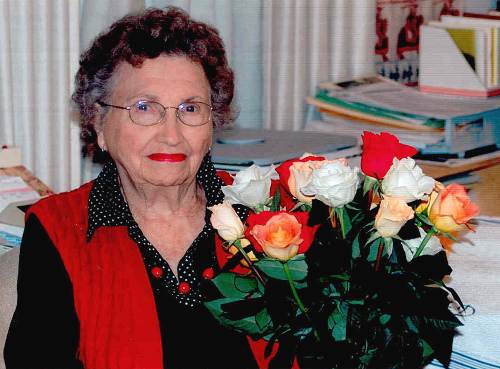
01 Mildred Messersmith Gray - Age 90 - 2007
Mildred has devoted many years to the pleasant endeavor of researching the stories of people and events having to do with Miller County and I have consulted her frequently about some of the subjects discussed on this part of our website. I have known Mildred for many years so when I began my participation with the Miller County Historical Society it was very natural that I would turn to her for the answer to many questions that arise from time to time about Miller County that no one else seemed to know. Mildred lived the early part of her life in Iberia but her high school years were spent in Tuscumbia. Her parents built the Hillcrest Café located just across Highway 52 from the Tuscumbia School. The Messersmiths’ lived in the rear part of the café when Mildred was going to school. She can remember the first school building, a wooden frame structure long ago replaced by the present school positioned farther to the north (photo 02).
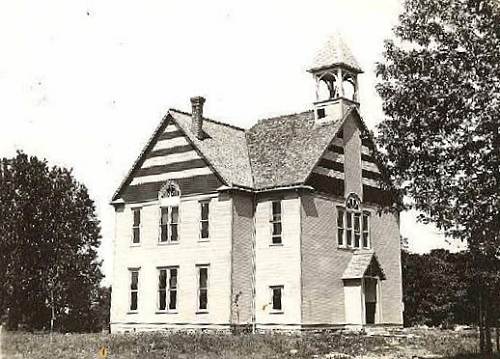
02 Old School - 1920
I also knew well her mother, Minnie (Small) Messersmith (photo 03), who frequently was in my home attending me when I was a child while my parents were out.
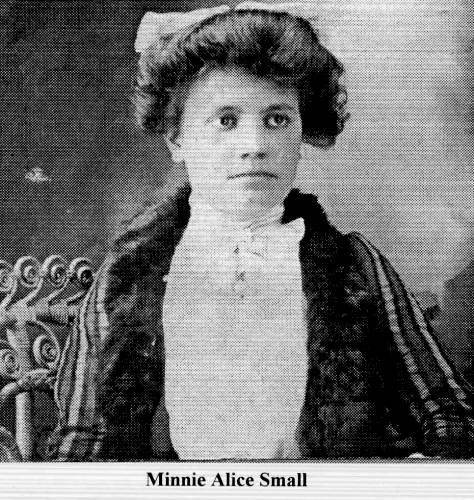
03 Minnie Alice Small Messersmith
Her sisters, Betty Lou and Juanita, were good friends of our family. I went to school with a couple of Betty Lou’s children, John Michael and Don Smith.
So I am happy this week to have the opportunity to feature the history of the Messersmiths’ as told by Mildred beginning with the story of her grandfather Hiram Messersmith (photo 04):
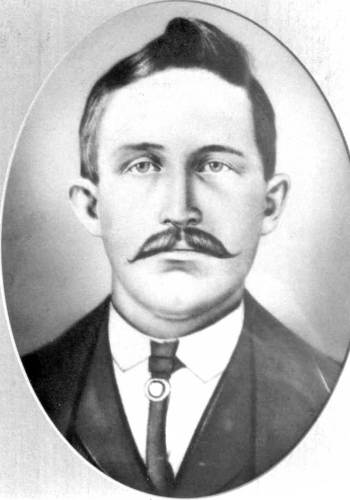
04 Hiram Messersmith
Hiram Messersmith
Born 12 August 1842; died 26 January 1926
Hiram Messersmith was born near the village of Hickory, Cole County, Missouri, son of Rufus and Sina Edgeman. He had a twin named Andrew J. Hiram’s name is on the 1850 census of Miller County in the household of his father, Rufus, and on the 1860 census of Miller County in the household of his mother. He was named as one of the heirs when his parents died. The next available record of him is when he joined the Home Guards (Union) when he was twenty.
At this time Missouri was in a terrible state of turmoil. People were about evenly divided in their sympathies between the North and the South. In between were the bushwhackers or night riders who roamed the countryside murdering, pillaging and burning. These guerrillas were riff-raff, loyal to neither side, but sometimes joining with one or the other. Jesse James and Frank James were among them as was William Qantrill.
Hiram joined the 47th Regiment Enrolled Missouri Militia as a private on 19 August 1862, just after his twentieth birthday.
For background, the following is taken from “The American Pageant” by Thomas A. Bailey:
“The purpose of the Missouri Militia, or Home Guards of which the 47th was a part, was to protect the citizenry. Later the armies of the North and South drew many of their men from the Home Guards and the State Guards. The Home Guards (Union) should not be confused with the State Guards (Confederate).
In Missouri, Claiborne F. Jackson was elected Governor at the same time Abraham Lincoln was elected President of the United States (1860).
C. F. Jackson was a Southern sympathizer and he planned to take Missouri out of the Union if the southern states seceded. In April 1861 Fort Sumter, South Carolina was fired upon and the southern states began to pull out of the Union. In his call to arms, President Lincoln asked Missouri for four regiments of infantry, but Governor Jackson bluntly refused. However in St. Louis, Frank Blair, a staunch Union supporter and a Republican, had organized a club called “The Wide Awakes” composed of both foreigners and native born Americans. Out of this club grew the military outfits, for many of the foreigners had military training in Europe. Frank Blair trained them secretly. Under Blair and Captain Nathaniel Lyon from Fort Riley, Kansas, seven thousand men moved against the St. Louis arsenal and the Governor’s man, General D.M. Frost, surrendered. It was Governor Jackson’s men who were known as the State Guard.
The State Convention deposed Governor Jackson and elected a Union man, Hamilton R. Gamble. Jackson left Jefferson City (the capitol) and moved to Neosho where he set up headquarters for his secessionist government which gave Missouri over to the Confederacy. Jefferson Davis accepted Missouri, so Missouri had two governors. General Sterling Price attempted to save Missouri for the Confederacy and while he won the Battle of Wilson’s Creek, near Springfield, Missouri, he never won another battle. And Missouri was saved for the Union.”
So Hiram joined the Home Guards in 1862. He served six months (174 days) or until his enlistment ran out. Then, as was the custom, he evidently farmed and stayed at home with his mother during the year of 1863.
When the war first broke out, both sides thought all they had to do was capture the capitols: Washington, D.C. or Richmond, Virginia and the war would be over. Old General Winfield Scott knew better and he advised Lincoln that it would take 300,000 men two or three years to crush the Confederacy. Lincoln’s first priority was to save the Union. The strategists’ plan was in four parts. First, they would blockade the southern coasts and capture the ports. Secondly, the Federalists would seize control of the Mississippi River because it was the backbone of the Confederacy. A later phase of the plan was to capture the capitol at Richmond and pound the remaining armies into submission.
The main battles in 1862 were Pea Ridge, Shiloh, Seven Pines and Cedar Mountain. In 1863 General Grant finally took Vicksburg, so the first phase of the plan was accomplished. The “Yankees” controlled the Mississippi River but the “Rebels” were fighting hard all over Mississippi, Tennessee, Georgia and Alabama. In February an additional company was added to the 12th Missouri Cavalry. It formed at St. Louis. This was Company I which a short time later became Company K. The war had only one more year to run. Recruiters were sent out over the State and on 19 February 1864 Hiram Messersmith enlisted at Jefferson City.
Hiram was twenty one years old and was described as five feet five with dark complexion, gray eyes and light hair. I remember his gray eyes but I think the sun darkened his complexion and bleached his hair. He gave his occupation as farmer and his enlistment was for three years or until the war ended. The recruiting officer, John T. Rice, filled out the enlistment papers. He spelled Hiram’s name as Hyreum M. Smith (This placed Hiram’s name in the “S’s” instead of the “M’s” which made research more difficult for me. Hiram made an “X” for his signature. He later learned to read and write.
Why did Hiram join the Cavalry? Perhaps any farm boy who could bring his own horse was accepted. Maybe they offered him a bounty. For whatever reason, he joined and received his first three months training at Scholfield Barracks near St. Louis. The cavalrymen were the “eyes of the army.” They went ahead of troops to scout and they often met the enemy in skirmishes. At one time the 12th Cavalry served as “pontooniers;” that is, they built pontoon bridges across streams and rivers. The record shows that some companies of the 12th Cavalry were on the move constantly all over the State of Mississippi. A cousin of Hiram’s, Hezekiah Messersmith, was also in the 12th Cavalry.
At St. Louis Hiram’s company boarded the steamer, “Atlantic” and moved down the Mississippi, landing at Memphis, Tennessee on “7 June 1864”…where,” wrote the company clerk, “we now remain in camp in a beautiful grove.” For these boys from hilly Missouri, the low lands were a death trap. Mosquitoes carrying malaria felled the soldiers, for this was forty years before the cause of malaria would be found. David McCullough in his book, The Path Between The Seas, about the building of the Panama Canal, describes malaria attacks this way:
“The typical malarial attack began with terrible chills, uncontrollable shivering and chattering teeth; the spell lasting perhaps fifteen minutes, sometimes more. The chills would be followed by a high fever and a burning thirst. As the fever fell off, the patient would break out in a drenching sweat. For those who survived, the experience was unforgettable. With the passing of the fever, the patient was left feeling totally debilitated. It was considered impossible to ever recover fully from malaria.”
And that is what happened to Hiram when his unit reached “the beautiful grove.” Many of his companions died, and Hiram was in and out of hospitals from then on with intermittent fevers. As a cavalryman the worst ailment was probably the “cavalryman’s complaint”…hemorrhoids. Hours and days in the saddle and a poor diet contributed to this, and Hiram suffered all the rest of his life. There was no effective treatment for it, either. Many years later, when he applied for a pension, he mentioned heart disease and kidney trouble as well as hemorrhoids.
But let’s look at his military record. Even though Hiram suffered from what the surgeons termed intermittent fever, he was present in camp some of the time. In May and June he was present in Camp Wells at Memphis. In July and August he was sick in the hospital at Memphis. His company was ordered to LaGrange, Tennessee and then on to reconnaissance at Ripley, Mississippi and later to Holly Springs, Mississippi. They moved to Waterford after driving the “Rebels” from Holly Springs; they encountered the enemy at Oxford, Mississippi and returned to Abbeyville. They were again ordered to drive the “Rebels” out of Hurricane Creek and arrived at LaGrange 28 August. It is assumed that Hiram missed these actions while he was ill with malaria. Later, in September and October 1864, he was present with his company near Lawrenceburg, Tennessee.
The 12th Cavalry pursued General Nathan Bedford Forrest (CSA) until 8 October. General Forrest had gone into Tennessee to tear up railroads and try to cause enough trouble to induce General Sherman (Union) to split his forces and send an army under General Thomas back to Nashville to contain him.
A bitter battle was fought at Franklin, Tennessee in November 1864 and in December the battle of Nashville ended the South’s struggle in the West. If Hiram only fought in the battles of Franklin or Nashville, that was enough to make him a hero to us, his descendants. Even though Hiram was too sick through most of the action, he was still a soldier, as were all the other boys on both sides…heroes to their own.
Part of the 12th Cavalry was at Athens, Alabama in November and December of 1864. Whether Company K was with them at Nashville would not have been known to us except for an affidavit made by the captain of K Company, John G. Woods, many years later. Captain Woods by 1884 was a banker living in Wellington, Kansas. He stated that he knew Hiram M. Smith well and had served as his captain. He said that Hiram M. Smith was with the company and participated in engagements with the enemy “before Nashville” in the month of December 1864 and that Hiram was in poor health due to exposure and other exertions during said engagements. Hiram was later taken sick with “rheumatism” and on or about 1 January 1865, while forging a river, Smith received a wetting which so increased his disorders that he was found unfit for duty and sent to the hospital where he remained away from his company until he was discharged. “Smith was a man of good character,” and as an affiant, Mr. Woods did not believe Smith induced, aggravated or prolonged his disease by intemperance or other bad habits.
When Captain Woods said “before Nashville,” did he mean in the battles they engaged in before the main battle at Nashville? Franklin for instance? Probably, for the battle at Nashville was in December and Captain Woods stated that Smith was in poor health in December and became worse after a wetting in January and found unfit for duty. According to the records, Hiram was in three hospitals: Adams General in Memphis; General Hospital in Jeffersonville, Indiana; and General Hospital at Jefferson Barracks in St. Louis. He probably was not bedfast all the time but was up helping other patients. His daughter, Sina, told her children many years later that Hiram was very good with sick people. No doubt he learned simple nursing in army hospitals.
Other affidavits given by men who served with him are interesting too. W.A. West, a resident of St. Elizabeth, Missouri stated that he served with Hiram Messersmith, and that they scouted the commands of Generals Forrest and Wheeler in Tennessee and Mississippi. W. M. Lawson also gave a deposition in 1886 that he had know Hiram since 1857 and had never known him to have any ailments before the war, and that he believed him to be a “sound and stout” man prior to the war. John W. Gibson of Hawkeye in Pulaski County, Missouri knew Hiram from the time Hiram was discharged from the army in 1865, and believed that Hiram was totally disabled in the war.
Hiram was discharged from the army in July 1865 at Louisville, Kentucky. He had been paid in April but he owed the army $4.93. The army paid him a bounty of $160 and he owed the U.S. $10. On the reverse side of the muster-out card is written: Department of Kentucky 1865. “Money value of clothing drawn since enlistment as shown by description list was $69.84.” It appears from the description list that “pay is due soldier from August 1864 to March 1865. He is entitled to traveling allowance and subsistence from Louisville, Kentucky to Jefferson City, Missouri.” A hospital card from the Jefferson General Hospital in Jeffersonville, Indiana gives Hiram’s hospital number (13724) and his ward and bed numbers. His age is twenty two; he is single; his residence is Miller County, Missouri; his next of kin is his mother, Sina M. Smith, Tuscumbia, Missouri. Rank is still Private, Company K of Missouri Cavalry. Eastport, Mississippi was the place where he was admitted to the hospital. The diagnosis was Febris Intermittens. The result and date: Hiram M. Smith was discharged from service July 1865.
Hiram’s mother, Sina, died about three years after his return. The family had probably been devastated economically as most people were. Hiram’s brothers had married and had families of their own so Hiram was the only one left to help his mother. By now she was evidently living in the village of Tuscumbia. His grandmother, Elizabeth Powell Messersmith, was still alive in 1865 and lived until 1870. In his History of Miller County, Gerard Schultz wrote,
“The Civil War ended in the spring of 1865 but peace had not returned to Miller County. Soldiers of the Union and Confederate armies returned to their old homes only to find lawlessness, robbery and murder…a combination which had begun during the war and persisted for several years after the close.”
In 1869 Hiram married Harriet Frances Rowden (1847 – 1918) the daughter of John Hardin Rowden and wife Sarah who lived on a farm east of Iberia. The farm had been homesteaded about 1839 by Sarah’s first husband, Andrew Lawson. After Andrew’s death, Sarah married her cousin, John Hardin Rowden and the place became known as the John Hardin Rowden farm and cemetery. Today, it is known as the Duncan farm and the Duncan Cemetery, but some of our Messersmiths and Rowdens are buried there.
Harriet Rowden Messersmith (Grandma Messersmith) was a member of a large family…several of whom were half brothers and half sisters to the Lawsons. They were: William, Mary “Polly”, George, Clarissa, Nancy Caroline and Margaret Louise Lawson. Her full blooded sister and brothers were: Anna, Daniel, James Hardin, Monroe and Abraham Rowden. Rowdens intermarried with Sheltons, Brandons and Lawsons making us related to many people in Miller County.
Hiram and Harriet brought up their children on their farm east of Iberia. In about 1880 they sold the place and moved to Iberia. They moved to Tuscumbia after 1900. In Tuscumbia they lived in a small house (which has since been torn down) near the Tuscumbia cemetery. For awhile they lived at the Old Soldiers Home at St. James, Missouri, but were evidently dissatisfied there and returned to Tuscumbia. In 1918 the flu epidemic struck and Harriet died. Her daughter Fidella (“Della”) came from Kansas to see her mother and she too caught the flu and died. Harriet was 71 and Della was about 34 at the time of their deaths. After Harriet died, Hiram came to live with his son, Charles (my father), where he remained until his death in 1926.
Hiram and Harriet were members of the Methodist Church in Iberia. Their children grew up with a strong interest in politics, education and religion. Several were musically talented which may have come from the Rowden side. I believe that Harriet was a child of a marriage between first cousins. They grew up at a time when necessities of life had to be worked for and luxuries were almost unknown. Hiram told my brother John that his grandfather (Barnabas Messersmith Jr. ) came to Missouri from Kentucky and was a great bear hunter. We have found no evidence that they were in Kentucky except in passing through. Virginia is where they came from.
Hiram and Harriet appear on the 1880 Miller County census in Osage Township, Family # 294A. Hiram’s age is given as thirty seven and Harriet’s as thirty two. Their children were Charlcie (eight), Charles (six), Sarah (four) and Sina (two). The census taker did not spell their names correctly as I have here.
They appear on the 1900 census of Osage Township, Miller County. They were still living in Iberia at this time: Family #45. Hiram’s age (fifty seven), Harriet (fifty one), Charles (twenty six), James (nineteen), Louisa Fidello (sixteen), and Hattie (fourteen). Sadie had died. Next door was their daughter, Sina, and her husband, Elmer Thompson. Charlcie and Dan Blanton were living on the Miller Maries county line, not far from Charlcie’s parents.
The 1910 census: Hiram and Harriet were living in Tuscumbia, Equality Township. They were Family #75. Hiram (sixty six), Harriet (also sixty six). The latter is an error as she was sixty two. Hiram’s occupation was given as shoemaker. Shoe cobbler is a more likely term; that is, a repairer of shoes. Their sons, Charles and James, also lived in Tuscumbia. Hiram gave Virginia as his father’s birthplace and Kentucky as His mother’s. Harriet died in the flu epidemic of 1918 so Hiram moved in with his son Charles and lived with our family until he died in 1906. Grandpa’s easy chair is in the possession of his great grandson, Ralph Barnhart.
I remember Grandpa Messersmith. He lived in our home from 1918 until his death in 1926. In his old age he was sick and beginning to lose his mind. He wanted to go back to his old home on Tavern Creek. Remembering him as he was then it is hard to visualize him as the hard riding, wild young cavalryman that he once was. My father and his brother and sisters always addressed him as, “Father.” My mother took care of him in his last years of illness even though she had small children to raise. My sister, Ida Helen, died a few hours before Grandpa, after a lingering illness.
We lived in both Iberia and Tuscumbia during the years Grandpa lived in our home. One of the houses we lived in at Iberia was next door to the GAR Hall (Grand Army of the Republic, an association of retired soldiers who fought for the North) where the old veterans met to reminisce. Grandpa would never visit his other children for very long. When he went to visit his daughter, Charlcie and her husband, Dan Blanton, he would get into arguments with Dan’s father, Jasper, who was also a war veteran. They would argue about politics, the war and religion and would almost come to blows. The little boy, Bennett, thought his two grandfathers were going to fight one day and he ran to get his father. The problem was, Hiram joined the Home Guard (Union) and Jasper joined the State Guards (Confederate). Jasper was captured by the Home Guards and Hiram got him a horse and helped him to escape. Instead of appreciating this, Jasper seemed to resent it.
At our house in Tuscumbia, a three room cabin was attached to the main house and this is where Grandpa lived. My brother, John, shared these rooms with Grandpa and helped take care of him. I remember two large photographs which hung on the wall in Grandpa’s bedroom. One was of him and it is reproduced for this story (see photo 04 above). The other was of his daughter, Sarah “Sadie.” Before this photograph could be copied for posterity, it was lost, much to my sorrow.
The clothes Grandpa wore looked like his Civil War uniform and they may have been although they would have been sixty years old. People did not throw away clothes in those days, and as I remember other old veterans wore their uniforms too. Grandpa was called Squire Messersmith both as a term of respect and because he was a Justice of the Peace.
Grandpa’s friends came to sit up with him in his final illness as was the custom in those days. The double funeral for my Grandpa and my sister, Ida Helen, was held January 1926 at the First Christian Church in Tuscumbia, across the street from our house.
Before continuing with Mildred’s story I want to include here an old newspaper article about the almost simultaneous deaths of Hiram and his granddaughter, Ida Helen Messersmith, which our museum director Nancy Thompson located. The particular newspaper of origin of the story is not named:
Unknown Publication, February 4, 1926
One of Tuscumbia's families was overshadowed in the darkest gloom and the town saddened last week when two deaths occurred in the home of Charles Messersmith. On Thursday evening at six o'clock, Ida Helen, their little daughter, passed away, and on Saturday at 4 o'clock, Hiram, the father of Charles, died.
Hiram was a pioneer citizen of Miller County. He was born in Cole County near Hickory Hill, August 14, 1842. The family moved to Miller County near St. Elizabeth when he was nine years old.
When the trouble arose between the North and the South, Hiram became a member of the Home Guards in 1861 and served two years. In 1863, he enlisted in the 18th Missouri Cavalry and served two years. He was engaged in a number of battles, including Tupelo, Miss., Selma, Ala.,Corinth, Miss., and Nashville, Tenn.
After the close of the war, 1869, he was united in marriage to Harriet Rowden of the east part of Miller County. His wife died in 1918 of influenza at Tuscumbia, his daughter, Idella, dying at the same time of the same epidemic. At that time he also had the influenza and since that time has been an invalid. He has been making his home with his son, Charles, since the death of his wife.
Ida Helen Messersmith was born at Tuscumbia July 21, 1916, died January 28, 1926 of a heart lesion or ulcerated heart valve. The family was living at Iberia when she had an attack of heart trouble, which brought about invalidism, the ailment probably being the result of an attack of influenza. When her father was elected assessor, she came with her parents to Tuscumbia and attended public school until November when she suffered a recurrent attack of the old trouble, and since then has hovered between life and death until the end came. Besides her parents, she is survived by one brother, John, and two sisters, Juaneta and Mildred.
Beautiful services were held at the Christian Church Saturday afternoon for the two. Rev. J.C. Thompson of Brumley, delivered the sermon.
This double funeral was more than unusual in that the Messersmith family in the past ten years has experienced two other similar sorrows. During the influenza epidemic in 1918, Mrs. Hiram Messersmith and her daughter, Mrs. Fidella Goodnough, wife of Edward Goodnough, also died within hours of each other.
Now to continue the Hiram Messersmith biography by his granddaughter, Mildred M. Gray:
Sons and Daughters of Hiram and Harriet Rowden Messersmith, Grandchildren of Rufus and Sina:
1. Andrew J. Messersmith II (b. 30 August 1870; d. 9 September 1870) first born son of Hiram and Harriet Messersmith. He was named for Hiram’s twin brother. Andrew J. lived only ten days . He is buried at the Duncan cemetery a few miles from Iberia. His little tombstone reads: “Gone to be an Angel.” It is shaped like a lamb.
This cemetery was part of the land Andrew Lawson homesteaded about 1839. Lawson was the first husband of Sarah Rowden, mother of Harriet Rowden Messersmith and grandmother of little Andrew J. It is almost certain that Sarah and her second husband, John Hardin, are also buried in that cemetery but there are no stones to mark their graves. It is my desire to someday erect a monument to my great grandparents.
2. Charlcie Ann Messersmith (b. 19 November 1871; d. 8 October 1947) the second child of Hiram and Harriet. She grew up on the farm near Iberia, a bright girl who learned easily and was an excellent speller. She married Daniel (Dan) Blanton at her parents home on 10 October 1889. Daniel was born in Osage county, Missouri (b. 18 February 1865; d. 8 October 1956). They became the parents of thirteen children. Charlcie and Dan made their home on a farm near VanCleve, a community close to Meta, Missouri. This location was on the Maries Miller county line. Their daughter Ruth said that half the house was in Miller County and the other half in Maries. Their descendants say that Daniel and Charlcie felt there was too much intermarriage among kin fold in Maries County so they bought a farm near Chilhowee, Missouri in Johnson County and there they lived the rest of their lives. It is true that the people of Maries, Miller and Osage Counties were of pioneer stock, many from Virginia and were closely related.
In Johnson county Dan and Charlcie were active members of the Shiloh Presbyterian Church. Dan was the superintendent of the Sunday School for fifteen years. They were interested in politics, religion and education. Dan was a Democrat so the arguments with my father, Charles Messersmith, a Republican, were lively ones. The area where the Blantons lived is called “Little Dixie” as many of the people were southern sympathizers. Ruth and Hazel believe that Dan’s father, Jasper Blanton, served in the State Guards (confederate) for a short time but in the Union forces later. They joined the United Daughters of the Confederacy on that belief.
The memories of going to Chilhowee to visit Uncle Dan and Aunt Charlcie are happy ones. Their sons and daughters were all musical and when my sister and I were teenagers, the Blanton boys took us to country square dances. Aunt Charlcie kept a lamp in the window and she waited up for us when we went out. When the time came to tell her goodbye, she would go out to feed her chickens so we wouldn’t see the tears in her eyes. She had a soft voice and she talked and laughed a lot. I remember that she made big biscuits to feed all those big boys.
Charlcie died at home, 8 October, 1947. Dan died at Warrensburg, Missouri, in 1956. They both are buried in the church cemetery at Shiloh Presbyterian Church.
3. Charles Marion Messersmith (my father) (b. 12 December 1873; d. 11 August 1939) (photo 10) third child of Hiram and Harriet. He was born just three years before the one hundredth anniversary of the Declaration of Independence.
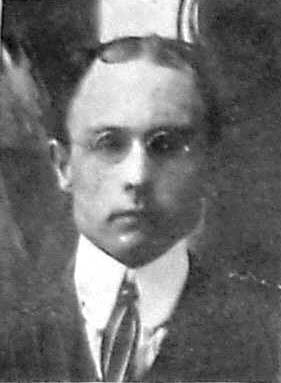
10 Charles Messersmith
All his life he was an avid reader and he and his sisters mastered the “blue back speller” in their childhood. He attended the Iberia Academy for one or two terms and qualified to teach when he was a young man. Always, he was fascinated with politics, preferring to talk to older people on that subject at gatherings where most young people were dancing.
Charles married Minnie Alice Small (b. 9 November 1886; d. 31 January 1981) on 5 May 1905. She was thirteen years younger than Charles. Minnie was the daughter of Arthur Elliott and Nancy Ann Hawken Small. Their first home was a small farm near Tuscumbia and it was here that their first son, John Charles was born. They were the parents of seven children but only four of us grew to adulthood. In 1918 Charles lost his mother and his sister, Della, in the flu epidemic. Charles and Minnie lost two young children, James and Olive Jean, to spinal meningitis the same year. As my brother said of this, “a story too sad to tell.” Charles and Minnie moved to Iberia in about 1920 and remained there until 1925. Another child, Ida Helen, died in 1926, the same day Grandpa Hiram died.
Charles was elected to the office of county tax assessor four times and was well known for his knowledge and efficiency. Charles was also a farmer on a small scale and a storekeeper as well as a teacher. When Charles was elected to office, we moved back to Tuscumbia where they lived out their lives.
John Messersmith, my brother, wrote this about our parents:
“My Dad operated stores in Tuscumbia and Iberia. He traded his little farm to Burley Abbett for a small grocery store in Tuscumbia in 1912. (I was born in the apartment above the store). This small business prospered and grew until he sold it and moved to Iberia in 1920 where he went into a larger mercantile business with a cousin, Charley Short. Iberia was blessed with too many sores of this kind at that time and the business finally failed and Dad lost his shirt. After some rather lean years, he was re elected to the office of County Assessor and we moved back to Tuscumbia in 1925. After another eight years in office, he was defeated in the election of 1932 when the Democrats swept the county. My father and mother founded the small business still known as Hillcrest in Tuscumbia. This business prospered from the beginning and is still prosperous and well located.”
Gerard Schultz wrote in his History of Miller County:
“In 1878, 3513 whites and 59 colored children enrolled in school. The average daily attendance was 33 days per year. The chief textbooks were Walker’s Dictionary, Smiley’s Arithmetic, The English Reader, Introduction to the English Reader and the Moral Instructor. One of the most popular and educational forms of entertainment was the spelling match. Pupils were drilled in spelling from the time they learned their ABC’s Whole communities attended the inter-school matches and quite often outsiders took part.”
Charles Messersmith was excellent all round student. The grades he made when he took the state examination for renewal of his teaching certificate are as follows:
Arithmetic 96
Language 98
Grammar 98
Geography 99
Spelling 85
Reading 99
Writing 95
U.S. History 100
Physiology 96
Agriculture 100
Pedagogy 98
He stated on 1 September 1911 that he had taught school for sixty months and had taken one course of study as laid down by the State Teacher’s Reading Circle. Perhaps it was at this time he attended the Iberia Academy which was founded about 1890.
The year 1918 was probably the most tragic of their lives. Influenza swept the county and they lost many relatives and friends after losing their little children earlier in the year.
Charles was elected president of the Tax Assessors Association of Missouri in about 1932. Charles and Minnie were operating Hillcrest Restaurant in Tuscumbia when he became ill with cancer. After four years of illness, the last months being of intense suffering, Charles died. (His cousin, Thomas Henry Messersmith, son of Thomas K. also died on 11 August 1939 in Utah). Until he was no longer conscious he wanted to know what was going on in his community, his church and the world. He asked that the St. Louis Globe Democrat be read to him every morning, even on his deathbed. When the family was gathered at home, he wanted to hear us sing around the piano. He chose the pallbearers for his funeral and we have the list in his handwriting. The speakers at his funeral were: Dr. G. Byron Smith, Reverend Virgil Smith, The Reverend A. L. Alexander and the Reverend Arthur Crouch. The funeral director was Clarence Casey of Iberia. The Reverend W.E. Waddell was in charge of the service.
Minnie, my mother, operated the family business for a time then rented hillcrest and moved to another house in Tuscumbia to rear her youngest child, Betty Lou. Minnie married twice more: 1) Victor Nixdorf who died three years later; 2) Fred Klindt. Minnie was ninety four when she died.
4. Sarah “Sadie” Hardin Messersmith (b. 14 February 1876; d. 30 August 1898) the fourth child of Hiram and Harriet. Hardin was her grandfather Rowden’s middle name. She was born on Valentine ’s Day but love went wrong for her. My father told my brother that the man she loved chose to marry another girl whose father was a well to do farmer During Sadie’s pregnancy she and her brother, Charles, read books together, one of which was Don Quixote. She and the baby died on the same day and are buried at Duncan Cemetery near Iberia and her tombstone read: “At Rest. Don C. Infant Son, Sarah M. Smith”
It is good to be able to add that her lover and his wife lived a long and unhappy life together, finally divorcing. Grandpa had a large photograph of his daughter, Sadie, which hung on the wall in his bedroom. That photograph is lost to posterity.
5. Sina Caroline Messersmith (b.25 March 1878; d. 2 December 1972) on a farm near Iberia, the fifth child of Hiram and Harriet. She was named for her grandmother, Sina Edgman Messersmith, but the derivation of the name is obscure. At times it was written Sinai and it was their descendants who presumed it to have come from the Old Testament. It has been spelled Sinea and it has been said by her children that sometimes Sina spelled it Sinah. Sina Edgman was born in Kentucky and on a census list for Wayne County, Kentucky there are two or three other women named Sina. I wonder about the name spelled Signe.
She too was an avid reader, and like her brother, Charles, she loved politics. She valued education and it was her desire that her children would have educational opportunities. Sina attended the Iberia Academy and at about the age eighteen she married Elmer Taylor Thompson (1870-1942) on 18 May 1896.
Elmer Thompson was born in Quincy, Illinois. His parents were Ferdinand C. and Elizabeth Craig Thompson. Another source states that her maiden name was Clemens, leading the family to believe they were related to Mark Twain. Quincy is across the Mississippi River from Hannibal, Missouri. His father was said to have deserted his wife and children according to a letter from his daughter in law. Elmer’s sisters were Ora Lee and Pauline. Although his descendants have searched for some record of Ferdinand, very little has been found. He may have died in New Orleans, Louisiana. Elmer must have retained some feeling for his father because he named his second son Eull Ferdinand.
Elmer was forced by circumstances to make his own way in the world so he left home at an early age. When he was about twenty three, he was one of the men who made the run when the Cherokee Strip was opened in the Oklahoma territory on 165 September 1893. Elmer won land which he later sold. Aunt Sina said the land he won later became the town of Blackwell. This event took place three years before Elmer married Sina in Missouri and how his travels took him to Iberia, Missouri is unknown to me. Was he on his way back to Illinois from Oklahoma?
Elmer and Sina first lived on a farm next to Sina’s parents for a few years, and there their first six children were born. They had ten altogether. A daughter in law (Dollie Thompson) thinks that Sina told her that the second son was born when Elmer was away. The little baby died within a few days. It seems reasonable to think that Eull Ferdinand would have been buried at John Hardin Rowden Cemetery near other members of the family, but there is no marker on his grave. Often graves were marked with only a fieldstone.
6. James (Jim) A. Garfield Messersmith (b. 11 November 1880 d. October 1936) (photo 11) was the sixth child of Hiram and Harriet. He was born nine days after James A. Garfield was elected president of the United States, so this is where he got his name.
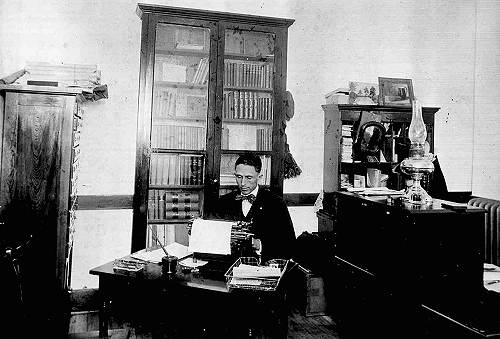
11 James Messersmith in Courthouse Office
President Garfield, a Republican, was shot on July 2, 1881 and died less than three months later. After he was grown, James did not use the initial “A” but his father wrote it that way when he listed his children on his pension application and in the family Bible.
James G. was able to get a little more education than his brother and older sisters had done, at Iberia Academy and the University of Missouri at Columbia. He was not only possessed of a keen mind but was musically talented and a handsome and charming man. He taught school in Miller County and served as the Principal at Tuscumbia High School in 1908 and 1909. While he held this position he introduced the new game of basketball to THS. Following this he became County Superintendent of Schools in Miller County from 1909 to 1916. . There are persons in their seventies in Miller County who remember Jim Messersmith as their teacher and for his outstanding abilities.
(Note: at this time in the year 2008, I doubt if anyone is still living who would have had James Messersmith as a teacher.)
He played various band instruments as well as the violin and was a member of the Tuscumbia Band.
He married Anna Clark (b.23 July 1889; d. July 1991) on 16 May 1909 at Tuscumbia. Anna was the daughter of James and Martha Hawken Clark and was a first cousin to Minnie Small Messersmith, the wife of James’ brother, Charles. Anna was also a schoolteacher. Their children were: Clark, Carl, Martha and Mary. Here is a photo of their home in Tuscumbia, which was just across the road from the Hillcrest Café of Charles and Minnie (photo 12).
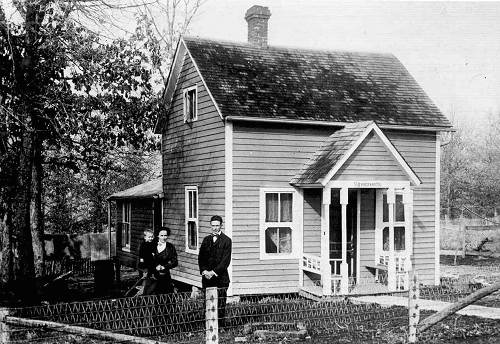
12 James Messersmith
When James became an insurance agent for Metropolitan Life the family left Tuscumbia and moved to Eldon. From there they moved to Fulton in Callaway County and finally to Linn Creek. During the building of the Bagnell Dam, James was employed by Stone and Webster. He and another man, Edwin Hancock, started a newspaper called the Lake Ozark News.
James was a member of the Christian Church when he was a young man, but later he joined the church of his parents (Methodist) at Linn Creek, where Anna was the Sunday School Superintendent and he sang in the choir. Their church presented a program at the radio station in Jefferson City at which time James sang a solo, “His Eye Is On the Sparrow.” (At our home in Tuscumbia, we tuned in and my father, Charles, on his sick bed, heard his brother’s song.)
He became ill in 1936 and died at St. Johns Hospital at Springfield, Missouri at age fifty five and ten months. As he was dying he heard a voice calling his name and he heard music. His funeral was held at the Christian Church at Tuscumbia and he was buried in his father’s family plot beside his parents, his sister (Fidello), and his brother Charles and family. Anna died just before her one hundred and second birthday.
7. Louise Fidello “Della” or “Dell” Messersmith (1 September 1883; d. 31 October 1918) was the seventh child of Hiram and Harriet. Della’s father had a sister named Fidello and her mother had a sister named Phideller Edgman, so it was probably the same name, different spelling. Later a niece would give herself the middle name of Fidella. Also Della’s father’s brother, Thomas Messersmith, would have a daughter named Fidella.
Della married Edward S. Goodnough (b.4 June 1883; d. 23 December 1941) on 26 November 1913. He was a railroad engineer and they lived in Kansas where he worked for the Union Pacific Railroad. Their first child, a son died at age one and their other child was a daughter named Eldora. In 1918, the flu epidemic swept the United States and Della’s mother, Harriet, became ill in Missouri. Della took her little daughter and went by train to Missouri to see her mother. Harriet died within a few days of Della’s arrival, whereupon Della took the flu and also died. Aunt Annie told me that Della was pregnant at the time of her death. She is buried in the Messersmith family plot at the Tuscumbia Cemetery. Edward came out from Kansas for the funeral and to take his child back home.
Edward remarried and Eldora lived with him and his second wife. Eldora came back to Missouri a time or two to visit her mother’s people and years later she revisited the cemetery where her mother is buried.
8. Harriet “Hattie” May Messersmith (b. 5 May 1886; d. 19 August 1928) was the eighth and last child of Hiram and Harriet. She was born at the home place near Iberia. Hattie was remembered with great affection by all who knew her. She taught school in Miller County and many who had been her pupils praised her for her ability as a teacher and for her sweet personality. She was like a breath of spring singing and dancing and talking and laughing.
Her nephew, Carl Messersmith, remembers her playing the piano and singing, “You gotta see your mama every night or you can’t see your mama at all. You gotta kiss your mama, treat her right, or she won’t be at home when you call.” Her children remember her being a feminist long years before that great revolution swept our country.
She married Reginald Bell (b. 8 March 1889; d. 14 September 1949) in 1908 and went to live at Cartersville, Missouri their first two daughters were born there. Later they moved to Kansas where he worked for the railroad as an engineer. They were parents of four children whom Harriet adored. Hattie suffered a heart attack and died when she was only forty one years old.
Thanks Mildred.
Mildred’s father, Charles (see photo 10 above) was a very well respected man during his lifetime. He was one of the citizens of the county whom Gerard Schultz chose to include in his History of Miller County written in 1933:
CHARLES MARION MESSERSMITH
By Gerard Schultz, 1933
Charles Marion Messersmith, former president of Missouri Assessors Association, was born about ten miles northeast of Iberia, on December 12, 1874. His father, Hiram Messersmith, came to Miller County from Cole County, where he was born on August 12, 1842. His mother, Harriet (Rowden) Messersmith, was born about ten miles northeast of Iberia. His paternal ancestors were originally German, while his maternal ancestors were from Tennessee and Alabama.
On May 14, 1905, Mr. Messersmith was married to Miss Minnie A. Small, daughter of Arthur and Nancy Small. Mrs. Messersmith's father was of English descent; her mother was German.
Mr. Messersmith is widely and favorably known in Miller County. He taught school in the county for 13 years and served four terms as assessor from 1901 to 1909 and from 1925 to 1933. He has exceptional knowledge of the county, especially about location of land, and extensive acquaintance with people. He has been president of the Missouri Assessors Association, chairman of the Republican Central Committee of Miller County, and a member of the Republican Congressional Committee of the Eighth District.
In politics Mr. Messersmith is of the Republican Party. He is an elder in the Church of Disciples of Christ. Three of his children, James, Olive Jean, and Ida Helen, are deceased. Four are living: John, who graduated from Draughon's Business College in 1927 and from the School of Mines and Metallurgy at Rolla, Missouri, in 1933; Juanita, who graduated from Iberia Junior College in 1933; Mildred, and Betty Lou, who are attending school at Tuscumbia.
As I mentioned at the beginning of this week’s narrative, the Messersmith family had more than its share of tragedy. The almost simultaneous deaths of Charles Messersmith’s mother,and Charles’ sister, Dell were recorded in the Autogram:
Miller County Autogram, October 31, 1918:
“Charles Messersmith’s family is just recovering from a very severe attack of the Spanish influenza. Mr. Goodnough of Kansas came Sunday to see his wife who contracted Spanish influenaza while visiting relatives. Mrs. Goodnough was formerly Miss Dell Messersmith.
The Spanish influenza is raging pretty severely in and around Tuscumbia and has claimed as its victims two of our citizens. Mrs. Hiram Messersmith, one of our eldest and most highly respected citizens, passed away Tuesday night after an illness of about a week. She had been in very delicate health for some time and a complication of ailments caused her death. The remains were laid to rest in the town cemetery yesterday afternoon. Obituary notice will appear later.”
And then about a week later, the daughter of Mrs. Hiram Messersmith, who had come to visit her mother, also died of the Spanish flu:
Miller County Autogram, Thursday, November 7, 1918:
Mrs. Dell Goodnough who contracted the influenza while here visiting relatives, died at the home of her father, Hiram Messersmith, at this place Thursday night. In addition to the influenza, pneumonia set in and death followed. The body was laid to rest in the Tuscumbia cemetery Friday afternoon. The deceased leaves to mourn her death, her husband, E.S. Goodnough, and little two year old daughter, besides her father, brothers and sisters and many other relatives. Mr. Goodnough and little child departed Saturday for his home in Kansas where he will place the little one in the care of his father and family.”
So, as just described above, Charles Messersmith lost his mother and his sister, Della, in the flu epidemic of 1918. But also in the same year of 1918, Charles and his wife, Minnie, lost two of their own young children, James and Olive Jean, to spinal meningitis. And then in 1926, another child, Ida Helen died the same day as Charles’ father, Hiram, died. It was thought that Ida Helen had contracted the flu in 1918 which caused a “heart ailment” which was said to have been the eventual cause of her death in 1926. Certainly, the Messersmith family experienced more than its share of tragedy, even for those days long ago when medical care was rather primitive.
The “Spanish Flu” epidemic of 1918 was worldwide and was the worst flu epidemic on record. In Miller County In 1918 the epidemic ran rampant. On Oct. 5, 1918, John Ferguson, chairman of Iberia's town board, ordered through a proclamation..."all schools, churches, and public places be closed during the prevalence of this influenza epidemic:” (Quoted from this website):
http://www.millercountymuseum.org/hake_peggy.html
You can read more about the Spanish Flu epidemic in America and the world at this website:
http://en.wikipedia.org/wiki/Spanish_flu
One of the late complications of the Spanish Flu was a form of Parkinson’s Disease called “Post Encephalitic Parkinson’s Disease.” My grandmother, Sadie Bear, who also contracted the Spanish Flu in 1918, suffered this complication of the disease which was progressive and eventually caused her early death. Here are photos of her before and after she developed Post Encephalitic Parkinson’s Disease (photos 13 and 14).
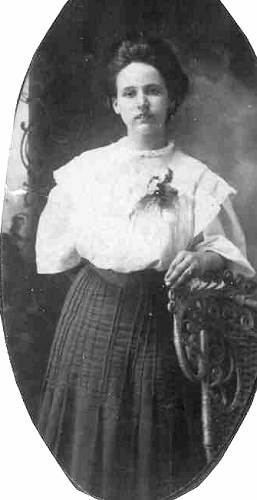
13 Sadie (Abbett) Bear
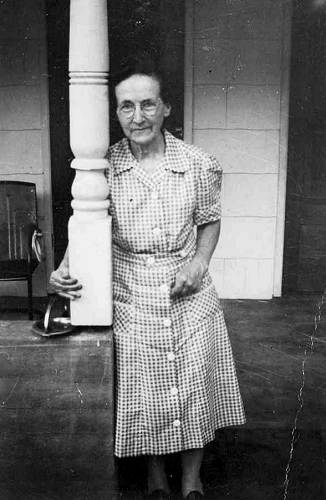
14 Sadie (Abbett) Bear
In the second photo notice that she has to hold onto the porch support to keep her balance. Her hands are flexed and stiff and the left thumb is tucked into the palm, a characteristic feature of Parkinson’s Disease. Also notice that while she is trying to smile, she has only a hint of smiling, another feature of Parkinson’s which is an expressionless face.
One of the more pleasant memories for the Messersmith family was when Juanita Messersmith, sister of Mildred, won the Miller County Centennial Queen contest in 1937. Here is a photo of Juanita in her Queen’s Gown (photo 15) as well as another photo of her on the Queen’s float (photo 16).
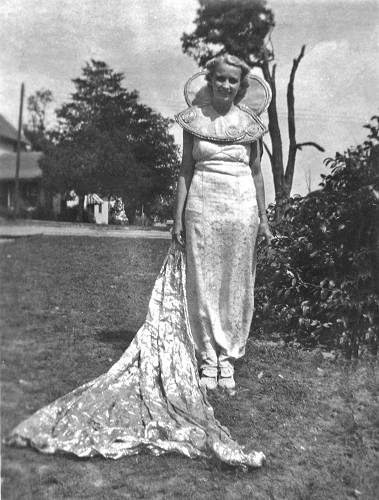
15 Juanita Messersmith - Queen of Centennial
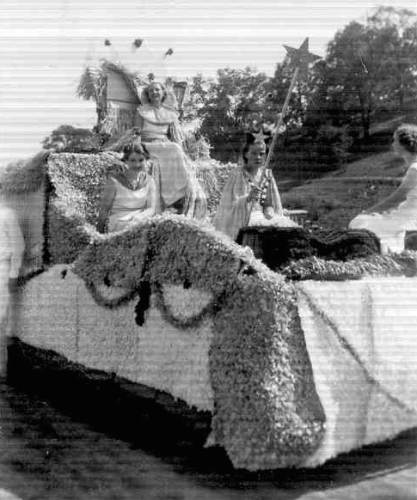
16 Juanita Messersmith - Centennial Queen Float
You can read more about the Miller County Centennial Celebration at this URL on our own website:
http://www.millercountymuseum.org/events/centennial.html
As noted earlier by Mildred, her father, Charles, built and ran the Hillcrest Café in Tuscumbia. The building is still present on the corner of High Street and Highway 52 in Tuscumbia, although it has had several remodelings and owners over the years.
Charles sold the café to Madison Bear who soon turned it over to his son, Arthur Bear and Garrett Berry. The next owners were Ernest and Laura Abbett who turned it over to Roscoe Dake. After Roscoe, the café returned to the Messersmiths’ when Betty Lou Messersmith and her husband Ellis Smith owned the restaurant for several years.
After their management the building was sold to Max Pryor and he rented it for office space. Kerry Rowden is the present owner of the building. Presently, it houses a hair dressing salon. Here is a current photo (photo 17) of the building which after several remodelings really does not appear as it used to; however, I am told that the original building was never removed although the interior and exterior have been changed several times.
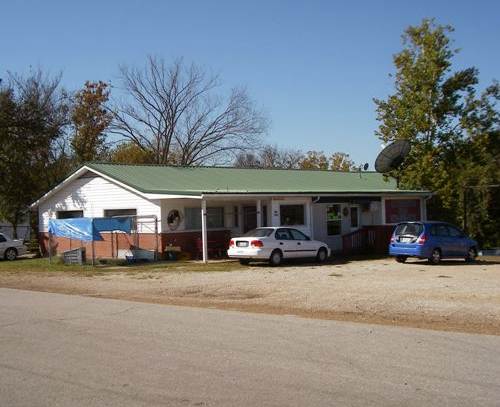
17 Messersmith Store Remodeled
That's all for this week.
|



